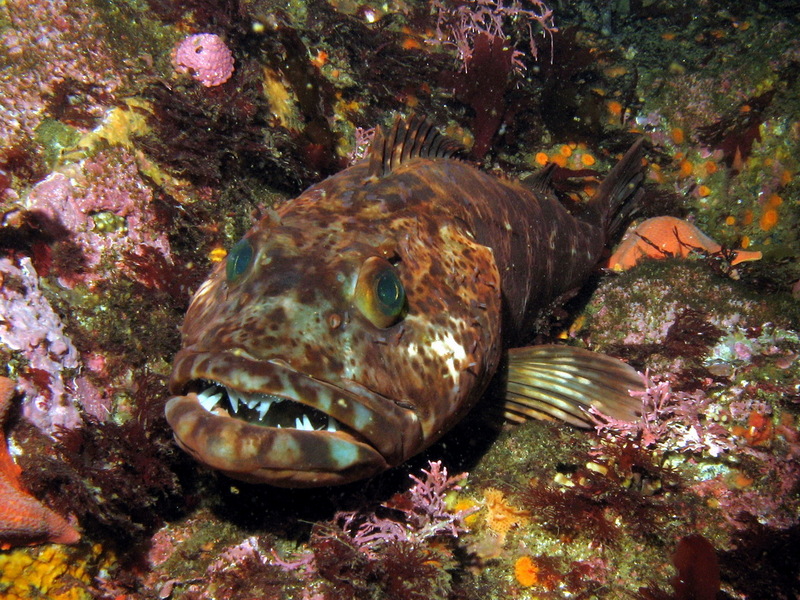Lingcod (Ophiodon elongatus) - Wiki Lingcod
From Wikipedia, the free encyclopedia
[Photo] Lingcod showing its teeth. Taken by Magnus Kjaergaard http://en.wikipedia.org/wiki/User:Kjaergaard at Monterey Bay, California. It is a Lingcod (Ophiodon elongatus).
The lingcod, Ophiodon elongatus, is a fish of the greenling family Hexagrammidae. It is the only member of the genus Ophiodon.
It is native to the North American west coast from Shumagin Islands in the Gulf of Alaska to Ensenada, Mexico. It has been observed up to a size of 152 cm and a weight of 59 kg[1] It is spotted in various shades of grey. The lingcod is a popular eating fish, and is thus prized by anglers.
Life history
Lingcod are unique to the west coast of North America, with the center of abundance off the coast of British Columbia. in Alaska there are many that reach 70 lbs. They are found on the bottom with most individuals occupying rocky areas at depths of 10 to 100 m. Tagging studies have shown that lingcod are a largely non-migratory species, with colonization and recruitment occurring in localized areas only. [2]
Starting in October, lingcod migrate to nearshore spawning grounds. The males migrate first, and establish nest sites in strong current areas in rock crevices or on ledges. Spawning takes place between December and March, and females leave the nest site immediately after depositing eggs. Males actively defend the nest from predators until the eggs hatch in early March through late April. The photo to the right shows a nest-guarding male protecting his egg mass.
The larvae are pelagic until late May or early June when they settle to the bottom as juveniles. Initially they inhabit eel grass beds, and eventually move to flat sandy areas that are not typical habitat of older lingcod. They eventually settle in habitats of similar relief and substrate as older lingcod, but remain at shallower depths for several years.
Females and males mature at age 3-5 years (61-75 cm) and age 2 years (45 cm), respectively. Adult males can be distinguished externally from females by the presence of a small, conical papilla behind the anal vent. Up to age 2 males and females grow at similar rates, with both reaching an average length of 45 cm. After age 2, females grow faster than males, with the growth of males tapering off at about age 8, and females continuing to grow until about age 12 to 14. Lingcod live up to a maximum of about 14 years for males and 20 years for females, reaching a maximum size of approximately 90 cm and 120 cm, respectively.
Lingcod are voracious predators, feeding on invertebrates and many species of fish, including herring, Clupea harengus, and Pacific hake, Merluccius productus. one of their favorite foods are smaller octopus, and will also rapidly devour large rockfish. Lingcod that survive the larval stages have few predators themselves, and are vulnerable mainly to marine mammals such as sea lions and harbor seals.
Age determination of lingcod
In 1977, Dr. Dick Beamish and Doris Chilton of the Pacific Biological Station published an article showing that cross sections of the 4th to 8th fin rays from the second dorsal fin provided a method for estimating the age of lingcod 1,2 . This method has since been validated by a mark-recapture study in which lingcod received an injection of oxytetracycline (OTC). Other methods of aging, such as those using scales and otoliths, were found to underestimate ages for older fish.
Ages are determined from fins in much the same manner as for other aging structures: sections of varying thickness are examined under a microscope, and the annuli, or rings, that are formed for each year of growth are counted and used to estimate the age. The cross sections must be made at right angles to the length of the fin ray, and it is therefore important that fins be dried flat, with the cut surface at right angles to the fin rays. In addition, the distance that the section is cut from the fin-ray base is important, and for this reason, all fins should be collected with the base intact.
One problem associated with using fin rays to age older fish, is that the fin-ray center may be resorbed, resulting in the loss of the first two annuli. It is therefore necessary to determine an average width for the first two annuli by examining the fins from juvenile fish. This measurement can then be used to estimate the position of the third annulus on older fish.
http://en.wikipedia.org/wiki/Lingcod
| The text in this page is based on the copyrighted Wikipedia article shown in above URL. It is used under the GNU Free Documentation License. You may redistribute it, verbatim or modified, providing that you comply with the terms of the GFDL. |
